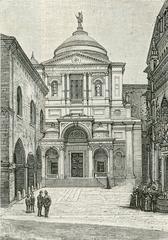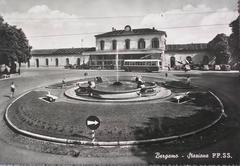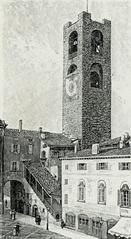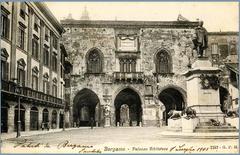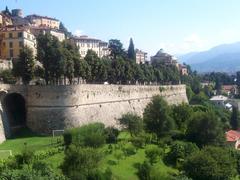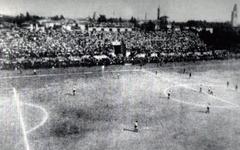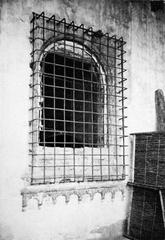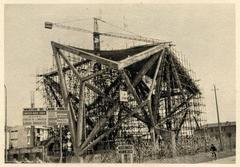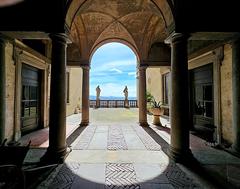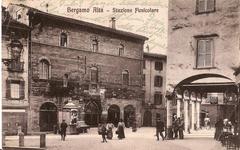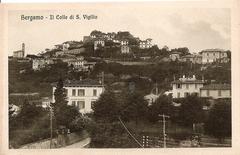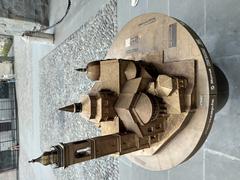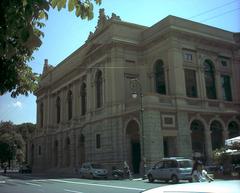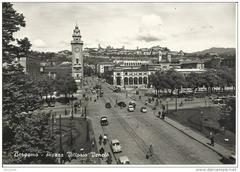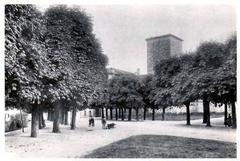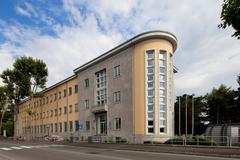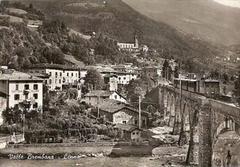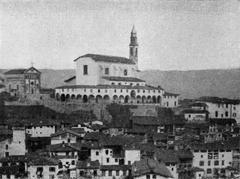Visiting Porta San Lorenzo: Hours, Tickets, and Historical Insights
Date: 18/08/2024
Introduction
Porta San Lorenzo, also known as Porta Garibaldi, is one of the most treasured historical landmarks in Bergamo’s upper city, known as Città Alta. This ancient gate, constructed between 1562 and 1563, reflects the architectural prowess and strategic significance of the Venetian Republic. The gate was named after the Church of San Lorenzo, which was demolished to make way for the fortifications (Wikipedia). Porta San Lorenzo’s historical importance is further underscored by its association with Giuseppe Garibaldi, who famously entered Bergamo through this gate in 1859, liberating the city from Austrian control (Wikipedia). Additionally, the Venetian walls, of which Porta San Lorenzo is a part, were designated a UNESCO World Heritage Site in 2017 (Wikipedia). This comprehensive guide will delve into the rich history, architectural features, and visitor information for Porta San Lorenzo, offering an insightful and engaging overview for anyone planning to explore this historical gem.
Table of Contents
- [Historical Significance](#historical-significancehistorical-significance)
- [Origins and Construction](#origins-and-constructionorigins-and-construction)
- [Strategic Importance](#strategic-importancestrategic-importance)
- [Closure and Reopening](#closure-and-reopeningclosure-and-reopening)
- [Architectural Features](#architectural-featuresarchitectural-features)
- [Restoration and Preservation](#restoration-and-preservationrestoration-and-preservation)
- [Historical Events](#historical-eventshistorical-events)
- [Cultural and Social Impact](#cultural-and-social-impactcultural-and-social-impact)
- [UNESCO World Heritage Site](#unesco-world-heritage-siteunesco-world-heritage-site)
- [Visitor Information](#visitor-informationvisitor-information)
- [Ticket Prices and Visiting Hours](#ticket-prices-and-visiting-hoursticket-prices-and-visiting-hours)
- [Travel Tips](#travel-tipstravel-tips)
- [Nearby Attractions](#nearby-attractionsnearby-attractions)
- [Città Alta](#città-altacitta-alta)
- [Basilica di Santa Maria Maggiore](#basilica-di-santa-maria-maggiorebasilica-di-santa-maria-maggiore)
- [Piazza Vecchia](#piazza-vecchiapiazza-vecchia)
- [Special Events and Tours](#special-events-and-toursspecial-events-and-tours)
- [Photographic Spots](#photographic-spotsphotographic-spots)
- [FAQ](#faqfaq)
- [Conclusion](#conclusionconclusion)
- [References](#referencesreferences)
Historical Significance
Origins and Construction
Porta San Lorenzo, the smallest of the four gates in Bergamo’s upper city, was constructed between 1562 and 1563 during the Venetian Republic’s rule. Named after the Church of San Lorenzo, which was demolished to build the walls, this gate stands as a symbol of the city’s history (Wikipedia).
Strategic Importance
In 1561, Bergamo was a border city between Venetian and Spanish territories. The construction of the Venetian walls, including Porta San Lorenzo, was crucial for defending the city. Despite its strategic importance, its location in a valley made it less defensible (Wikipedia).
Closure and Reopening
Porta San Lorenzo was closed in 1605 due to its vulnerability but reopened in 1627 at a higher level. This reopening, which cost 4,000 ducats, facilitated access to the city from surrounding valleys and Como. The original entrance remains visible today (Wikipedia).
Architectural Features
Built of sandstone, the gate features a single opening topped by a panel that once displayed a fresco of the Lion of Saint Mark. Unlike other gates in Bergamo, it lacks a bas-relief of the Lion, featuring a faded painting by Francesco Domenighini instead (Wikipedia).
Restoration and Preservation
A 2013 restoration project revealed that the masonry bridge leading to the gate, built in 1627 and supported by five arches, had never undergone major renovations in 400 years, highlighting its durability (Wikipedia).
Historical Events
Porta San Lorenzo is notable for its association with Giuseppe Garibaldi, who entered Bergamo through this gate on June 8, 1859, after liberating the city from Austrian control. A plaque commemorates this event (Wikipedia).
Cultural and Social Impact
Known for its rustic design, Porta San Lorenzo was primarily used by common people. The simplicity of the gate reflects its intended use (Wikipedia).
UNESCO World Heritage Site
On July 9, 2017, the Venetian walls of Bergamo, including Porta San Lorenzo, were designated as a UNESCO World Heritage Site, recognizing their historical and cultural significance (Wikipedia).
Visitor Information
Ticket Prices and Visiting Hours
Porta San Lorenzo is accessible year-round, and there is no entrance fee. However, it’s advisable to check local sources for any changes in visiting hours or special events.
Travel Tips
- Best Time to Visit: Spring and autumn for mild weather.
- Accessibility: Suitable for all visitors, though some areas may have uneven ground.
- How to Get There: Easily accessible by public transport or on foot from Bergamo’s city center.
Nearby Attractions
- Città Alta: The upper city of Bergamo, known for its medieval atmosphere.
- Basilica di Santa Maria Maggiore: A stunning basilica with rich history and art.
- Piazza Vecchia: The heart of Bergamo’s old town.
Special Events and Tours
Guided tours are available and provide in-depth historical context. Special events are often held in the area, especially during local festivals.
Photographic Spots
- Bridge Leading to Porta San Lorenzo: Offers picturesque views of the gate and surrounding landscape.
- City Walls: Provide a panoramic backdrop for memorable photos.
FAQ
What is the historical significance of Porta San Lorenzo? Porta San Lorenzo is a historical gate in Bergamo, built during the Venetian Republic’s rule and significant for its strategic and architectural features.
Are there any entrance fees? No, Porta San Lorenzo is free to visit.
What are the best times to visit? Spring and autumn offer the best weather for visiting.
Conclusion
Porta San Lorenzo stands as a testament to Bergamo’s rich history and strategic importance. Its rustic charm, historical significance, and accessibility make it a must-visit site for anyone exploring Bergamo’s upper city. Be sure to include this historical gem in your travel itinerary and explore the many stories it has to offer.
